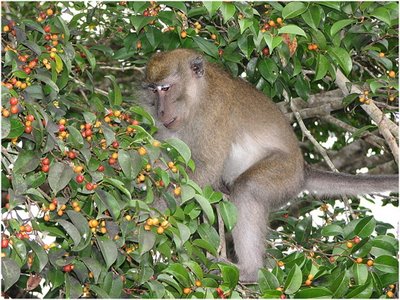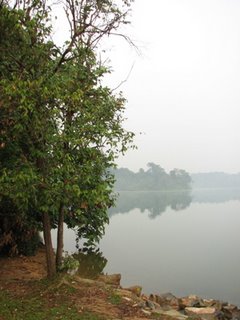 There was once an impressive fig tree growing by the water’s edge at Upper Seletar Reservoir (above). It was a Benjamin fig (Ficus benjamina), also known as waringin. It used to fig regularly but as far as I know, there was no pilgrimage by enthusiastic birdwatchers – as with the fig tree at Buklit Timah (1, 2 and 3).
There was once an impressive fig tree growing by the water’s edge at Upper Seletar Reservoir (above). It was a Benjamin fig (Ficus benjamina), also known as waringin. It used to fig regularly but as far as I know, there was no pilgrimage by enthusiastic birdwatchers – as with the fig tree at Buklit Timah (1, 2 and 3). Whenever the tree figged, there were the regular long tailed macaques (Macaca fascicularis) and there were birds but they did not come in droves that were seen at Bukit Timah. And I am sure if a birdwatcher was to keep count, the number of species visiting the tree would be very much lower than at the tree in Bukit Timah.
Whenever the tree figged, there were the regular long tailed macaques (Macaca fascicularis) and there were birds but they did not come in droves that were seen at Bukit Timah. And I am sure if a birdwatcher was to keep count, the number of species visiting the tree would be very much lower than at the tree in Bukit Timah.Now why is this so? The tree at the summit of Bukit Timah is at the highest point in Singapore. It is visible to all the birds that fly around the vicinity. Obviously, when the tree figs, it will attract hundreds of birds from all around the area. And when these birds land to feast on the figs, the noise generated will in turn attract other birds.
On the other hand the tree by the edge of the reservoir at Upper Seletar is not at a vantage point. It was clearly visible only from the reservoir end. It definitely did not enjoy the excellent position of the Bukit Timah tree.
But this does not mean that bird species was low. What it means is that there were not many birdwatchers observing the tree at the right time.
 According to Meng and Melinda Chan who were there on the 7th October 2006 and who provided the images, the tree subsequently collapsed and has now been chopped down (left).
According to Meng and Melinda Chan who were there on the 7th October 2006 and who provided the images, the tree subsequently collapsed and has now been chopped down (left).  Melinda has the last word: “Such a majestic tree overlooking the water… The last figging brought a lot of monkeys feeding. For once, it was fun watching them feeding on fruits growing on the tree, not handouts from people in cars.
Melinda has the last word: “Such a majestic tree overlooking the water… The last figging brought a lot of monkeys feeding. For once, it was fun watching them feeding on fruits growing on the tree, not handouts from people in cars. “The birds were frightened away by the monkeys. Only saw the Yellow-vented Bulbul (Pycnonotus goiavier), Asian Glossy Starling (Aplonis panayensis) and Javan Myna (Acridotheres javanicus) feeding on the figs. And yes, the Yellow-rumped Flycatcher (Ficedula zanthopygia) was there, but not for the figs.”
Input by YC and Melinda, images by Meng and Melinda Chan.
No comments:
Post a Comment